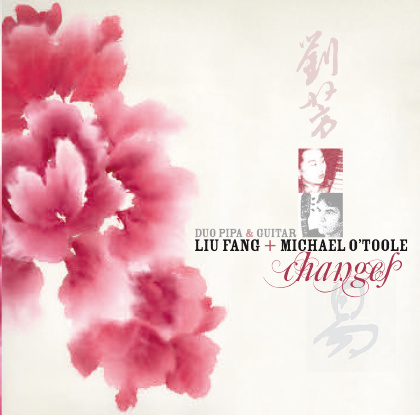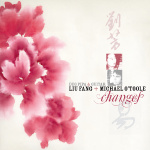
Songs
- artist:Liu Fang
- featured artist:Liu Fang and Michael O'Toole
- region:North America
- release year:2008
- style(s):Classical, Contemporary
- country:Canada
- formats:CD (Compact Disc)
- record posted by:Philmultic Management & Productions Inc.
- label:Philmultic Management & Productions Inc.
- publisher:Philmultic
- buy this record
Links
Liu Fang and Michael O’Toole
"Changes"
Duo pipa & Guitar
an extraordinary musical meeting between east and west, ancient traditions and modernity.
Title: "Changes" - Duo pipa & guitar
Performers: Liu Fang and Michael O'Toole
Genre: Classique and contemporary
Label: Philmultic
Cat. No.: PMPCD808
Release: August 2008, Montreal
Internationally-acclaimed Chinese pipa virtuoso Liu Fang and the renowned Irish classical guitarist Michael O'Toole has recorded a new album of duo pipa & guitar in a unique and exciting collaboration that brings together wide variety of repertoire from classical and traditional music to contemporary works.
The pipa (Chinese four-stringed Lute) and guitar have evolved from a common ancestor over many centuries into very different instruments and following continuous adaptations and modifications, are both eminently suitable for solo as well as modern ensemble playing. The beautiful, crystalline sound of the pipa is elegantly complemented by the warm, rich tone of the guitar. The combination of these two instruments creates a new flamboyant sound which, while steeped in their respective histories, is also refreshingly modern and surprisingly versatile. From the beautiful subtle melodies of 'Sai Shang Qu' to the daring adaption of Philip Glass' masterpiece 'Company' to the raucous rendition of Bartok's Romanian Dances, Liu Fang and Michael O'Toole display stunning virtuosity and endless adaptability. The combination of pipa and guitar gives an incredibly fresh perspective to existing masterpieces by a wide range of composers from Vivaldi to Piazzolla. In addition to this, the recording contains beautifully sensitive performances of new works by Ian Wilson and Toshiuki Haraoki, marking the duo's commitment to new music. The varied nature of the repertoire on the cd shows how successful this combination can be in the hands of two such talented performers.
The pieces (tracks) and samples
(10 pieces, 56.1 minutes)
[1]. Yao Dance (Chinese Traditional) 5:45
Originally composed for orchestra by Liu Tieshan and Mao Yuan in the 1950s, inspired by the dance music of the Yao people during traditional festivals, when people dress up, gather under the moonlight and beat long drums. There is a marked contrast to be felt between slow lyrical passages and the energetic rhythms which emerge and eventually bring the piece to it's exciting conclusion.
[2]. Company (Philip Glass, 1937-) 7:34
Composed in 1983 for the dramatization of legendary Irish writer Samuel Beckett's prose poem 'Company', this four movement piece has since achieved huge popularity because of the composers gift for simple melodies and effective use of cross-rhythms. Glass has had an incredibly varied and prolific career, writing music for successful films such as 'The Hours' and 'Mishima' and being feted around the world as one of the truly original voices of contemporary music.
[3]. Nightclub (Astor Piazzolla, 1921-1992) 5:54
Astor Piazzolla moved effortlessly between styles during his musical life, playing bandoneon in jazz or folk bands as well as studying classical composition with the great composer Alberto Ginastera. This piece was originally written for flute and guitar as part of the composer's 'Histoire du Tango'. It is a perfect example of Piazzolla's style, combining an indepth knowledge of classical and jazz harmony with an instinctive natural flair for tango, the sensual rhythmic dance of his homeland Argentina.
[4]. Sai Shang Qu (Chinese classical tradition) 7:26
This piece, in the typical lyrical style of the traditional pipa repertoire, is said to represent the sorrowful song of the Han dynasty (206 BC - 220 AD) noblewoman,Wang Zhaojun, a famous beauty who had to marry a barbarian prince for political reasons, sacrificing herself to the oppressor to save her country. This melancholic melody reflects her nostalgia, having realised that she would never see her friends and family again.
[5]. Concerto for pipa and Guitar (Antonio Vivaldi, 1678-1741) 6:51
i Allegro
ii Largo
iii Allegro
This piece, originally a concerto for mandolin and orchestra in C Major (RV425), illustrates Vivaldi's capacity to write in a lighter, more accessible manner then many of his contemporaries. Indeed Bach himself studied the Italian maestro's work before composing his famous Brandenburg Concerti. Vivaldi lived the life of a humble priest and his name endures today through works such as this one and the unforgettable 'Four Seasons' violin concerti.
Three Pieces for pipa and Guitar (Toshiyuki Hiraoka, 1964-)
[6] I Wish 2:01
[7] Water Necklace 3:22
[8] Twisted Illusion 2:58
World premiere recording. These works with their hypnotic, captivating melodies, evoke the serenity and grace of Japanese culture. Toshiyuki Hiraoka (Japan) has been actively involved in the music scene for a long time, having compsosed music for a number of movies.
[9]. Spillieart's Beach (Ian Wilson, 1964-) 6:23
Ian Wilson is one of the most successful composers to emerge from Ireland in recent times. His music has been performed and broadcast on six continents. 'Spilliaert's Beach was inspired by Belgian artist Leon Spilliaert's painting 'Moonlit Beach' (1908). The composer remarks: "This is a dark, almost abstract work, with a single shining focus, and these characteristics were what I wanted to echo in my work."
[10]. Romanian Folk Dances (Bela Bartok, 1881-1945) 6:58
i Joc Cu Bata
ii Braul
iii Pe Loc
iv Buciumeana
v Poarga Romaneasca
vi Maruntel
Hungarian composer Bela Bartok is regarded as a true giant of twentieth century music. His work, while distinctly modern in a classical sense, pulsates with the rhythms and nuances of Eastern European folk music. Throughout his life, the composer devoted much time and energy to collecting, notating and cataloguing folk tunes of his people and the stirring melodies of this piece emanate from such endeavors. Bartok's classical training can be felt in some of the complex rhythmic and harmonic accompaniments but he always preserves the integrity of these beautiful melodies.


